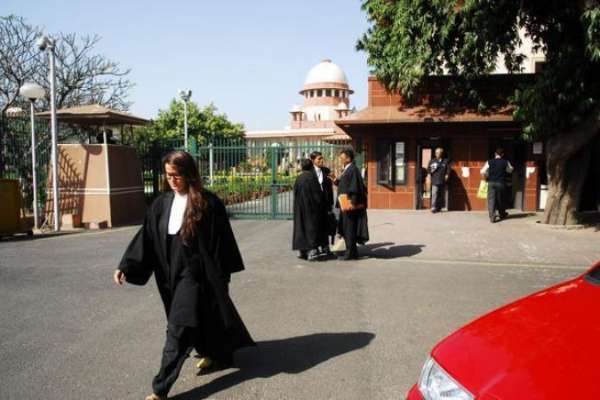Find out the important landmark cases on Public Interest Litigation which one must study for All India Bar Examination and an amazing quiz from our exclusive AIBE: BarHacker Course PIL.

-
- Bandhua Mukti Morcha v. Union of India and Others AIR 1984 SC 802– The Supreme Court gave directions to end child labour. The orders eventually led to enactment of Child Labour (Prohibition and Regulation) Act 1986.
- M. C. Mehta & Another v. Union of India & Others AIR 1987 SC 1086– This PIL was filed after the oleum gas leak from Shriram Food and Fertilisers Ltd. complex at Delhi. The Court laid down the concept of absolute liability.
- Sunil Batra v. Delhi Administration and Others AIR 1978 SC 1675– Case was with respect to reforms related to prisoner’s rights. There is no total deprivation of a prisoner’s rights of life and liberty. Court went further into the right to be protected from torture and the right to speedy execution.
- Hussainara Khatoon & Others v. Home Secretary, State of Bihar, Patna AIR 1979 SC 1369– Free legal services to the poor and the needy is an essential element of any ‘reasonable fair and just’ procedure. A prisoner has to seek his liberation through the court’s process, and thus, should have legal services available to him.
- People’s Union for Democratic Rights & Others v. Union of India & Others (1982) 3 SCC 235– The scope of Article 23 is wide and unlimited and strikes at “traffic in human beings” and “beggar and other forms of forced labour” wherever they are found. The word ‘force’ must therefore be construed to include not only physical or legal force but also force arising from the compulsion of economic circumstances which leaves no choice of alternatives to a person in want, and compels him to provide labour or service even though the remuneration received for it is less than the minimum wage.
- Sheela Barse v. State of Maharashtra AIR 1983 SC 378– The term ‘life’ in Article 21 covers the living conditions of the prisoners, prevailing in the jails. The prisoners are also entitled to the benefit of the guarantees provided in the Article subject to reason able restrictions.
- Dr. Upendra Baxi (I) v. State of Uttar Pradesh and Another 1983 (2) SCC 308 – Case regarding inhuman conditions which were prevalent in Agra Protective Home for Women. The court heard the petition on a number of days and gave important directions via which the living conditions of the inmates were significantly improved in the Home.
- Shri Sachidanand Pandey & Another v. The State of West Bengal & Others (1987) 2 SCC 295– State-owned or public-owned property is not to be dealt with at the absolute discretion of the executive. Certain principles such as public interest are to be observed. Whenever a problem of ecology is brought before the Court, the Court is bound to bear in mind Art. 48 A and Art. 51A(g) of the Constitution.
- Kharak Singh v State of UP AIR 1963 SC 1295– Personal liberty is that which is the residue after taking out the freedom of expression under Article 19. Right to privacy is not guaranteed under Article 21.
- Olga Tellis v. Bombay Municipal Corporation AIR 1986 SC 180– Supreme Court has held that the right to livelihood is included in the right to life because no person can live without the means of living i.e. the means of livelihood. This is the street vendors’ case.
- Citizens for Democracy v. State of Assam & Others (1995) 3 SCC 743– Handcuffing and chaining in public shall be shunned as violative of human dignity within and without prison.
- M. C. Mehta v. Union of India (1997) 2 SCC 353- (Taj Trapezium Case)-SC ordered unconditional closing down of all brick-kilns located within 20 km radius of Taj and in the Taj Trapezium Area. This case also expanded concept of environment as including national heritage and also expanded scope under Article 32 since it said even foreigners have a right to enjoy our national heritage and thus, their rights must be protected.
- D. K. Basu v. State of West Bengal (1997) 1 SCC 416– The Supreme Court laid down specific guidelines required to be followed while making arrests.
- Avinash Mehrotra v. Union of India and Others (2009) 6 SCC 398- the Supreme Court of India interpreted the right to education as inclusive of the right to the provision of a safe environment in schools, and imposed an obligation on schools to comply with certain fire safety precautions which were detailed in the judgment.
- Vishaka & Others v. State of Rajasthan & Others (1997) 6 SCC 241– The Court laid down guidelines and norms to be observed to prevent sexual harassment of working women. The judgment led to enactment of Sexual Harassment of Women at Workplace (Prevention, Prohibition and Redressal) Act, 2013
- Subhash Kumar v. State of Bihar and Others AIR 1991 SC 420- Right to life under Article 21 includes right to clean environment.
- M.C. Mehta v. Union of India and Others (1988) 1 SCC 471– (Ganga Water Pollution Case)- Despite of sufficient provisions under the water act, the Kanpur Mahapalika did not take necessary steps to prevent pollution. SC issued directions to it for the same. Held rights of people residing near Ganga must be protected against pollution.
- Vellore Citizens Welfare Forum v. Union of India and Others AIR 1996 SC 2715– the Court discussed the concept of sustainable development as iterated in the Stockholm Declaration and Rio Declaration. Stated it is a part of international customary law. Emphasized on the need to balance development with ecological concerns. Also, ruled that Polluter Pays and Precautionary Principle are a part of the law of the land.
- Re. Noise Pollution AIR 2005 SC 3136– Freedom from noise pollution is a part of the right to life under Article 21 of the Constitution.
- Vineet Narain & Others v. Union of India & Another AIR 1998 SC 889– This case concerns the Hawala scandal in India, which uncovered possible bribery payments to several high-ranking Indian politicians and bureaucrats from a funding source linked to suspected terrorists. The Court laid down guidelines to ensure independence and autonomy of the CBI and ordered that the CBI be placed under the supervision of the Central Vigilance Commission (CVC), an independent governmental agency intended to be free from executive control or interference.
- Centre for Public Interest Litigation v. Union of India and Another AIR 2003 SC 3277– This PIL arose out of misallocation of licences / radio spectrum by Ministry of Communications and Information Technology in January 2008 to provide 2G services. The licences granted to the private respondents and subsequent allocation of spectrum to the licensees were declared illegal and were quashed. Directions were issued for fresh grant of licences and allocation of spectrum for 2G services on the basis of fresh recommendations by TRAI.
- Indian Council for Enviro-Legal Action v. Union of India and Others (1996) 5 SCC 281– Bicchri Case- Case by an NGO on behalf of the residents of Bicchri village against the chemical industrial plants producing toxic effluents. Government had not taken necessary action to protect rights of citizens to a healthy environment under Article 21, and thus, it falls upon the Supreme Court to intervene under Article 32. Imposed strict and absolute liability on the industrial plants, and issued other directions.
- State of M.P. v. Narmada Bachao Andolan (2011) 7 SCC 639– The PIL was regarding resettlement and rehabilitation of people displaced because of construction of Sardar Sarovar Dam. The court introduced a mechanism to monitor the progress of resettlement pari passu with the raising of the height of the dam through the Grievance Redressal Authorities (GRA) in each party state.
- Manohar Lal Sharma v the Principal Secretary (2014) 9 SCC 516– The Court declared the Coal allocation between 1993 and 2009 illegal, arbitrary, non-transparent and devoid of any procedure.
- RK Garg vs. Union of India AIR 1976 SC 1559- constitutional validity of Special Bearer Bonds (Immunities and Exception) Act, 1981 was under challenge on the ground that it made an unreasonable classification between persons who illegally evaded payment of tax as against those who abided by the law. SC upheld the legislation. Held that that morality was not an element to be considered while judging the constitutional validity of a statute.
- Mohd. Haroon v. Union of India (2013) 11 SCALE 675– the PIL was with respect to the communal violence in Muzzafarnagar and neighbouring areas and emphasized on the deteriorating condition of victims of these riots. The Supreme Court directed the State of U.P, to take immediate charge of all persons who are stranded without food and water supplies, and to set up relief camps providing all required assistance, in association with the Central Government.
- Ajay Bansal v. Union of India (2013) 7 SCALE 568- the PIL was related to provisioning relief to people stranded in and around Gangotri river due to floods. The Supreme Court expanded the scope of the PIL so as to cover all affected areas of the State of Uttarakhand. The Court directed that for all affected persons, immediate relief will continue to be provided by district magistrates of respective districts by giving them food, medicine, drinking water and other essentials including fuel wherever necessary.
- Harshad J. Pabari v. State of Gujarat (2013) 3 GLR 258– the PIL sought a direction to authorities to take appropriate action against the responsible officer/staff for disclosing the identity of patients suffering from H.I.V./ AIDS by affixing a tape on forehead of patients with the words “H.I.V. seropositive” printed on it. The high court gave directions to end such unfair discrimination against H.I.V./AIDS patients by doctors including the nursing staff of a hospital. immediately.
- Laxmi v. Union of India (2013) 9 SCALE 290- the PIL highlighted the need for stringent regulations under the Poison Act, 1919 in respect of acid attacks on women. The Supreme Court gave measures for the proper treatment, after care and rehabilitation of the victims of acid attack and needs of acid attack victims, and compensation payable to acid victims by state or the creation of a separate fund for payment of compensation to the acid attack victims.
- S.P. Gupta vs. Union of India (1997) 3 SCC 433– The SC recognised the locus standi of bar associations to file PILs. In this case, they had legitimate interest in challenging the procedure for transferring judges.
- Inaction of Police in Lodging FIR’s in Offences Against Women v. State of U.P. (2013) 83 ALLCC 559- the Allahabad High Court took suo moto notice of inordinate delay on part of the police to register the FIR with respect to offences against women. The High Court held that it was the duty of the police to be aware of the statement, especially when it is given by the victim in an injured condition and to act on that basis if a cognizable offence is disclosed.
- PUCL vs. Union of India (1997) 3 SCC 433- The court recognized that the right to food was part of Article 21 and, therefore, justiciable. The government has a positive duty to help prevent malnutrition and starvation.
- Bachpan Bachao Andolan v. Union of India (2013) 7 SCALE 507– the Supreme Court issued a direction that in case a complaint with regard to any missing children was made in a police station, the same must be reduced into an FIR and appropriate steps should be taken to see that follow up investigation was taken up immediately.
- Dattaraj Nattuji Thaware v. State of Maharashtra 2005 (1) SCC 590- the Supreme Court of India stated that Public Interest Litigation has now come to occupy an important field in the administration of law and stated that PIL should not become ‘publicity’ or ‘private’ interest litigation. The court stressed the necessity of imposing ‘exemplary” costs on people for bringing frivolous petitions.
- Voluntary Health Association of Punjab v. Union of India (2013) 1 SCALE 383- the PIL complained of non-implementation of section 17 of the Pre-conception and Pre-natal Diagnostic Techniques (Prohibition of Sex Selection) Act, 1994 by the states and Union Territories and the failure to achieve its objectives. The court directed the health secretaries of the concerned states to apprise the court of the steps taken to implement the provisions of the Act and to make available the latest statistics of the number of cases booked for violation of the provisions of the Act, the prosecutions launched and the conviction rate.
- Research Foundation for Science v. Union of India (2013) 7 SCALE 497– the PIL pertained to the supply of potable drinking water to the eighteen identified areas surrounding the Union Carbide Factory in Bhopal. The Supreme Court had held that there should be a monitoring committee to oversee the part of the work being undertaken by the Bhopal Municipality for providing fresh drinking water.
- Kapila Hingorani v. State of Bihar, 2003 (6) SCC 1– A letter was admitted as PIL which brought Supreme Court’s notice to many incidents of death owing to starvation or malnutrition due to non-payment of salaries of the workers working in PSU corporations. The court pierced the corporate veil in this case and also held the State of Bihar liable.
- Municipal Council, Ratlam v. Vardichan (1980) 4 SCC 162– In this case, the court accepted the locus standi of the citizens of a ward to seek directions against the Municipality for taking remedial action under Section 133 of the Code of Criminal Procedure and putting an end to the nuisance caused due to open drains, pits and public excretion in the absence of lavatories.
- G. Sundarrajan v. Union of India (2013) 7 SCALE 102– The PIL was filed against the setting up of power plant at Kudankulam. The court justified the setting up of the plant, by emphasizing on striking a balance between the ecology and environment on one hand and the projects of public utility on the other.
- Bodhisattwa Gautam v. Subhra Chakraborty (1996) 1 SCC 490 the Supreme Court suo moto awarded an interim compensation of Rs. 1,000 per month to a victim of rape. The court observed that a woman, in our country, belongs to a class or group of society who are in a disadvantaged position on account of several social barriers and impediments and have, therefore, been the victims of tyranny, at the hands of men with whom they, under the Constitution, enjoy equal status.
- Noida Enterpreneurs’ Association v. New Okhla Development Authority (2013) 14 SCALE 475 – the PIL filed to sought a thorough probe into the allotment of land and plots and the abuse of power by the functionaries of NOIDA after the arbitrary allotment of plot in NOIDA generated huge litigation in Allahabad and Delhi High Courts. The court directed all the persons concerned to show cause as to why allotments/alternative allotments made in their favour may not be quashed.
- News Item Hindustan Times A.Q.F.M. Yamuna v. Central Pollution Control Board and Ors., 1999 (5) Scale 418- The Hon’ble Supreme Court took suo moto cognizance of the news item on pollution of Yamuna river. Directed Central Board to conduct investigations in the cities of Ghaziabad, NOIDA and Modi Nagar with a view to having an assessment of environment impact and to the status of pollution due to generation of different types of wastes.
- Sector 14 Residents’ Welfare Association & Ors. Vs State of Delhi & Ors AIR 1999 SC 308- regarding the discharge of effluents from the Delhi territory through Shahadra/Gazipur drai which pass through various sectors of the NOIDA area. SC directed creation of committee to look into the issue.
- Vincent Panikurlangara vs. Union of India 1987 SCR (2) 468- PIL for directions for implementation of an adequate central policy and establishment of a central drug standards authority, with suitable enforcement powers to ban “harmful and injurious drugs”. Held- “A healthy body is a very foundation for all human activities. In a welfare state therefore, it is the obligation of the state to ensure the creation and the sustaining of conditions congenial to good health.” The right to health was a part of the right to live with human dignity under Article 21.
- Rural litigation and Environment Kendra, Dehradun and others v. State of U.P. and others (1985) 2 SCC 431- the PIL involving issues relating to environment and ecological balance with implications to the welfare of the generality of people living in the country. The Supreme Court held that Article 2l covers the right to a clean environment and that the permanent assets of mankind cannot be allowed to be exhausted.
- Bhartiya Janta Party v. State of West Bengal AIR 2013 Cal. 215 – the PIL challenged the validity of the decision of the Government of West Bengal to grant honorarium to the Imams and Muazzins of different mosques in the State of West Bengal. Held-the state could not patronise or favour any particular religion and reiterated that secularism is part of the basic structure of the Constitution. Thus, violation of Article 14 and 15(1) of the Constitution.
- Somdev Kapoor v. State of West Bengal (2013) 12 SCALE 434 – the PIL pertained to cancellation of temporary liquor license on the ground that it was not open for the appellant to run a liquor bar in the said restaurant which was in the vicinity of religious places. Rule 8 of the West Bengal Excise Rules, 2003 bans grant of a license for the retail sale of liquor or any other intoxicant at a new site which is within 1000 feet from any college/educational institution /religious places. Both High court and Supreme Court allowed the PIL, while directing the excise department not to renew the license.
- Khatri v. State of Bihar 1981 (1) SCC 627– A writ petition was filed in the Supreme Court contending the violation of fundamental rights of prisoners in Bhagalpur Central Jail under Articles 14, 19 and 21 of the Constitution, and the court came to their rescue. The court stressed on the need for implementing public interest litigation in very explicit terms stating that the court should be prepared to forge new tools and devise new remedies for the purpose of vindicating the most precious of the precious fundamental right to life and personal liberty.
- Parmanand Katara v. Union of India 1989 (4) SCC 286 -the Supreme Court accepted the application by an advocate which highlighted a news item titled ‘Law helps the injured die’. The supreme court in the context of medico-legal cases, has emphasised the need for rendering immediate medical aid to injured persons to preserve life and the obligations of the State as well as doctors in that regard.
- In Re: Regularization of Class IV Employees (2013) 8 ADJ 43– the suo moto PIL by the Allahabad High Court, examined the legality of the regularization of 355 daily labourers working in Allahabad High Court. The high court was of the view that though in service matters, PILs were rarely admissible, in the present case, it was the cause of the high court itself that had been noticed by the judges for resolving an intricate problem relating to the workforce of the high court.
Cases explaining locus standi for PILs
- Bar Council of Maharashtra v. M. V. Dabholkar and Others 1976 SCR 306.
- Mumbai Kamgar Sabha, Bombay v. Abdulbhai Faizullabhai & Others AIR 1976 SC 1455
- S.P. Anand v. H.D. Deve Gowda and Others AIR 1997 SC 272,
- D.C.Wadhwa v. State of Bihar 1987 SCR (1) 798
- Fertilizer Corporation Kamgar vs. Union of India (AIR 1981 SC 149
- Hussainara Khatoon & Others v. Home Secretary, State of Bihar, Patna AIR 1979 SC 1369
Quiz
1.) Interpretation of which of the following Article has gives rise to Environmental PILs in India?
A.) Article 21
B.) Article 23
C.) Article 24
D.) Article 10
2.) PIL in Supreme Court can be filed under which Article of the Constitution?
A.) Article 32
B.) Article 226
C.) Article 227
D.) Article 136
3.) PIL can be directly filed to Supreme Court
A.) Yes
B.) No
C.) Yes, only in cases of pollution
D.) Yes, only in cases related to poverty schemes
4.) Indian judiciary introduced the concept of PIL in which of the following cases?
A.) Maneka Gandhi v Union of India
B.) ADM Jabalpur v. Shivakant Shukla
C.) SP Gupta v. Union of India
D.) None of the above
5.) Which of the following case relaxed the rule of locus standi?
A.) Golakhnath v. State of Punjab
B.) Sheela Barse v. State of Maharashtra
C.) Bar Council of Maharashtra v. M. V. Dabholkar
D.) None of the above
6.) In which of the following cases a Public Interest Litigation was filed against Ganga water pollution?
A.) MC Mehta v. Union of India
B.) PUDR v. Union of India
C.) Lilly Thomas v. State of Uttar Pradesh
D.) None of the above
7.) Which of the following scam was unearthed by a Public Interest Litigation?
A.) Fodder Scam
B.) 2G Scam
C.) Bofors Scam
D.) None of the above
8.) Which of the following PIL case made provisions for seperate lock-ups for women?
A.) Veena Sethi v. State of Bihar
B.) People’s Union for Democratic Rights & Others
C.) Sheela Barse v. State of Maharashtra
D.) None of the above
9.) Which of the following Public Interest Litigation case mandated 27% reservation for OBCs?
A.) Indra Swahaney case
B.) Hussainara Khatoon case
C.) Sunil Batra case
D.) None of the above
10.) Which PIL case established right to pollution-free environment as a fundamental right?
A.) MC Mehta v. Union of India
B.) Subhash Kumar v State of Bihar
C.) Council For Environment Legal Action v/s Union of India
D.) None of the above
To find more study material for administrative law for All India Bar Exam, please click here.











